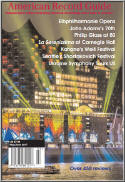|
Reviewer: John
W. Barker
Recordings of Bach’s solo
cantatas by countertenors are somewhat infrequent.
The composer himself apparently
used boy altos in such works. With today’s abundance of able countertenors
the range can now be served well with mature voices. Philippe Jaroussky has
been active for some years now and has an established reputation in concert,
opera, and recordings. Iestyn Davies has been coming up rapidly in both
recorded and public appearances—an emergence I have been following with
delight. Both singers have smooth and reliable voices: Jaroussky’s seems to
me a bit feminine, even girlish, in character. By contrast, Davies’s voice
is lovely and suave, joined with artistic sensibilities that make one less
concerned with judging him as a countertenor and more simply enjoying his
beautiful singing for its own sake. I admit to approaching these two
releases with an advance bias on the side of Davies, whom I consider perhaps
the leading exemplar of his vocal type. Jaroussky rivals Davies in two of
the three cantatas that the latter sings. Cantatas 54, Widerstehe doch der
Sunde, and 170, Vergnugte Ruh’, beliebte Seelenlust, are good Pietistic
preachments against sinning, while 82, Ich Habe Genug, is a pious
preparation for death. The texts deal with a range of moods, some dramatic.
Both singers approach their assignments in a contemplative and thoughtful
spirit, but with extra depth of feeling on the part of Davies. It seems to
me that his singing has a more natural flowing quality, sometimes a
comforting tenderness, as against a rather more calculated approach to
phrasing by Jaroussky. Two of them contain arias that are quasilullabies (in
82 it is the independently famous ‘Schlummert ein’), and both call for
obligatos from oboe d’amore or oboe. Bach left Cantata 82 in three
versions—for bass, for soprano, and for alto. The last of these is not so
often heard. Both singers give standout performances, but I would take the
Davies as the new benchmark recording of the alto version. Choice between
the two releases might also come down to their accompanying material. For
Hyperion, the three cantatas are interlaced with the sinfonias to two other
ones. These are orchestral introductions that Bach cobbled up from movements
in his Brandenberg Concertos: an expansion of the first movement from
Concerto No. 3 for Cantata 52 (Falsche Welt, dir Trau ich Nicht!), and an
early form of the first movement of Concerto No. 1 for Cantata 174 (Ich
Liebe den Hochsten von Ganzem Gemute). Jaroussky’s two Bach cantatas are
interspersed with two cantata rarities by Telemann. One depicts the agonies
of Jesus in the Garden of Gethsemane, and then at the moment of his
expiration on the cross. Their mix of moods is surprising, and Telemann’s
responses to the words are carefully designed. It should be noted, however,
that these two were originally written for bass and are here sung an octave
up, to fit the alto voice. Both releases are blessed with expert
accompaniment in the cantatas. Numbers are almost identical: 23 (including
the director) for Arcangelo, 24 for the Freiburgers. Both groups give fine
period-instrument support in the cantatas, but Cohen’s group has a brighter,
more spontaneous sound, vivaciously animating the two sinfonias. In both
cases, the sound is exemplary, in Hyperion’s case so much so that one is not
even prompted to think about it. Both releases have splendid booklet notes,
along with full texts and translations.
Fermer la fenêtre/Close window
|





